Elio Motors Brings Latest Prototype, Stock Sale & Other News to Detroit
Posted on Dec 23, 2016 in Editorials | 2 comments

The small crew of folks who make up Elio Motors brought the latest, fifth generation, developmental prototype of their reverse trike to the 2016 North American International Auto Show in Detroit. Paul Elio gave a press conference going over what progress the company has made moving towards actual production, including some details about their recent stock offerings that will fund the building of 25 pre-production prototypes.
I’ll get to the press release stuff in a bit. First I want to talk about the car, errr, autocycle, and the third-class of motor vehicles for which the company is lobbying regulatory acceptance.
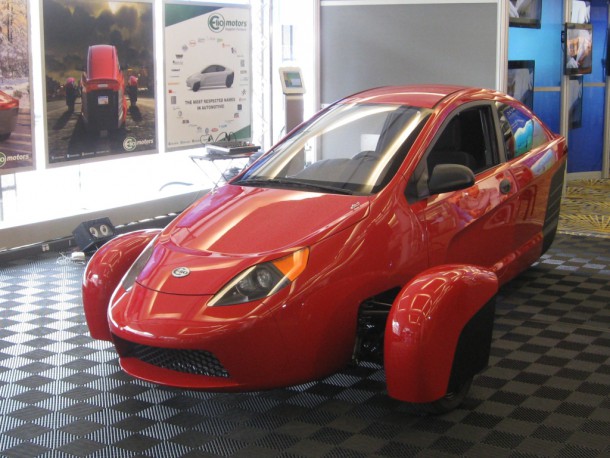
Regarding the P5 prototype, it’s still a prototype but generally looks much more production ready than the P4 I test drove in 2014. There have been some slight styling changes to the outside and substantial revisions to the interior since the P4 (and even a few new things since the P5 was first shown to the public at the Los Angeles auto show).
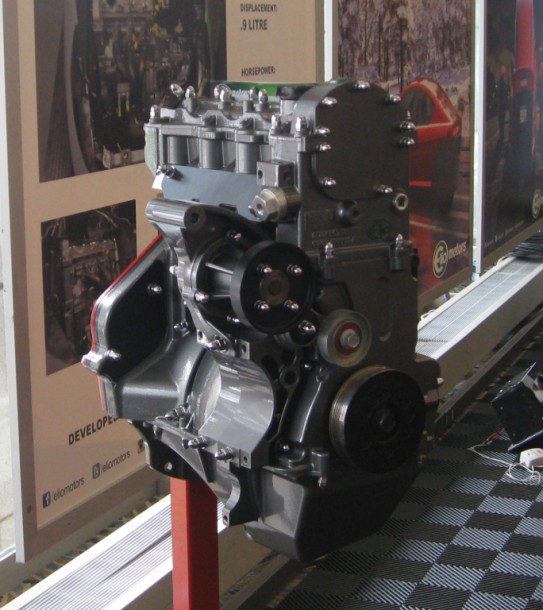
The most important differences however, are mechanical. The P5 is powered by Elio’s own IAV-designed inline 0.9-liter three-cylinder gasoline engine that produces 55 horsepower and not the Suzuki motor from a Geo Metro used in previous prototypes. The latest prototype also has the production transmission, a manual five-speed unit supplied by Aisin (an automatically operated version of the same basic gearbox will also be available).
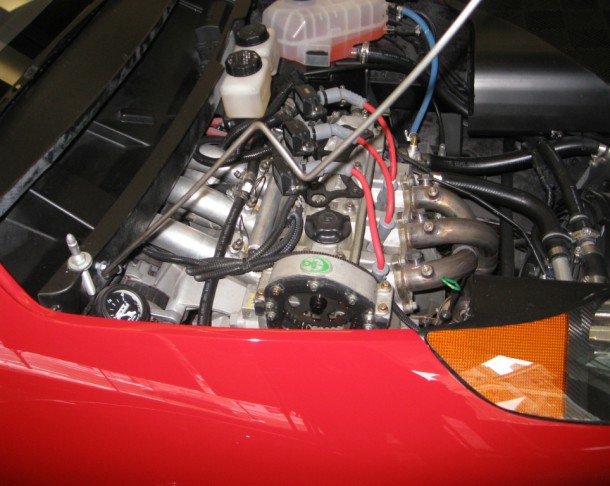
The car is operational enough to have had some some preliminary shakedown drives, including moderate speed runs for shooting the video they were showing in their booth, but it won’t be ready for someone like me to take the wheel until this summer.
The nose of the trike has been sharpened and the headlamp shape revised. The side windows for the rear passenger are much larger. I can’t say for sure without seeing them side by side, but I believe the windshield is larger too. The shape of the fenders for the outrigger front wheels has been revised. On the right side of the Elio, which has no door, a boxed exhaust housing runs along the rocker panel that exits just in front of the rear wheel. Yes, like the Viper, the Elio trike has side pipe[s].
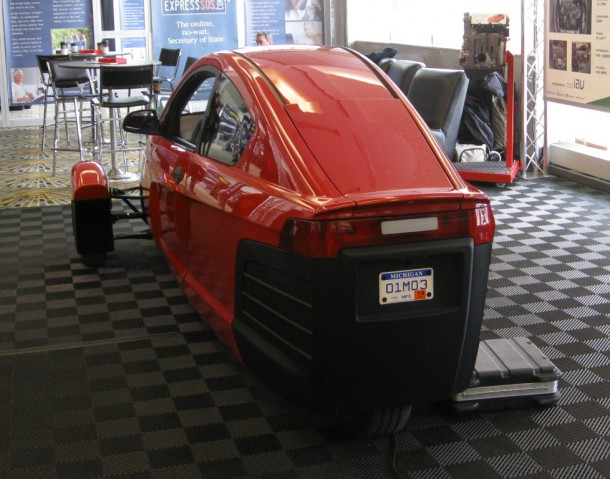
The P5 uses a steering rack that’s close to the production one and the turning circle has been much improved. When I test drove the P4, that was one of my criticisms, slow steering and a relatively wide turning circle for such a short wheelbase car. I believe they said they are aiming for a turning radius of 24 feet or less.
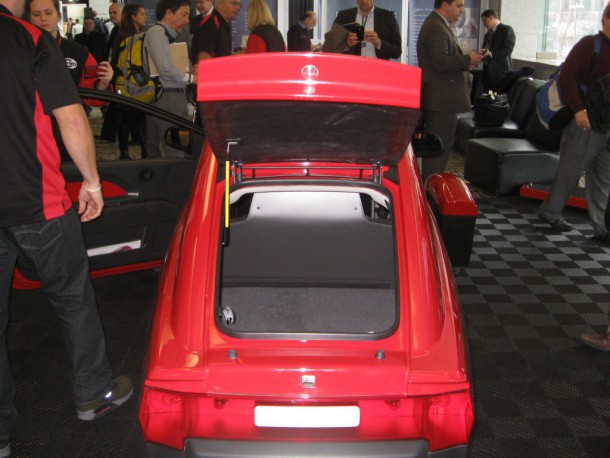
With the rear seat up, there’s enough cargo room for some groceries and a briefcase.
In Los Angeles, the P5 had an acrylic windshield and no windshield wiper, prompting some criticism from Elio skeptics. At the Detroit show, the P5 was sporting both a production spec windshield and a single-arm windshield wiper. I was told that the hood will be modified so the wiper will be hidden when not in use — not for aesthetics but because aero is critical to reaching Elio’s goal of 84 mpg on the highway. To keep tooling costs down on the prototype, body panels are still made of fiberglass. The production vehicle will have panels made of sheet molding compound (SMC).

With the passenger seat down, the cargo bay will hold a set of golf clubs. The valet at your club will likely not park it near the Rolls-Royces.
Besides the windshield and drivetrain, there are some other production components that have been incorporated in the fifth gen prototype, like the lower control arms for the front suspension.
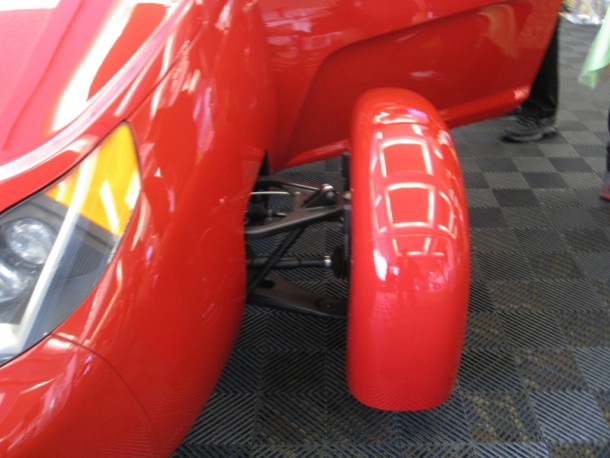
Inside the enclosed trike, there have been substantial changes to the interior design. To begin with, the cabin feels noticeably larger; there’s a lot more shoulder room. The instrument panel, repurposed from an off-the-shelf component similar to many of the vehicle’s parts, is the production unit first shown at the New York Auto Show last spring.
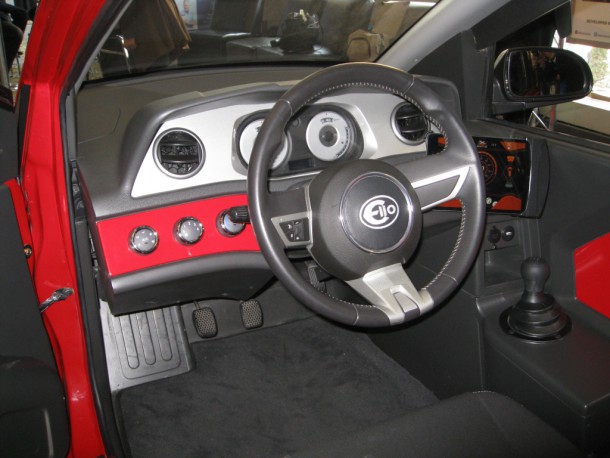
I’m told that the production Elio will have a cup holder.
Though Continental will still be supplying much of the Elio’s electrical system, the company has decided to not use Continental’s technology for infotainment. Instead, Elio announced that the production trike will feature a modular, upgradable infotainment and audio system supplied by MTX Audio controlled by a tablet mounted to the right of the steering wheel. Elio, which has been promoting their trike all along as made in America, touted how MTX agreed to manufacture the components for Elio at one of their U.S. factories.
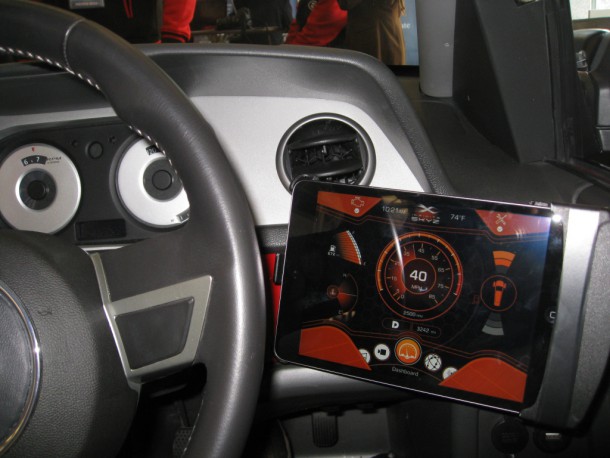
As mentioned, the rear side windows have been increased in size so the back seat area is less claustrophobia inducing — but it’s still not roomy. Elio lowered the seat cushion so taller folks can sit back there. I was able to get in and sit without removing my fedora, though I am shorter than the average adult male.
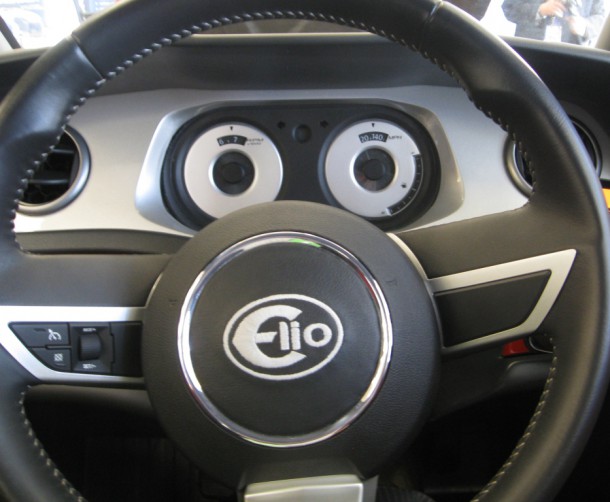
Here and there you can see signs that it’s still a prototype. The taillamp housings are nowhere near DOT spec and a few of the plastic parts inside don’t fit perfectly, but it looks like much progress has been made.

So much for the Elio vehicle. What about the company’s news?
Well, Elio is going public. Still struggling to raise the $200 million they need to start production (Paul Elio remains optimistic about getting a large loan from the ATVM program at the U.S. Dept. of Energy), they’ve made a couple of stock offerings over the past year that apparently have raised enough funds to move forward.
The first stock offering was to accredited investors and the company said it sold enough stock during that offer to be able to fund the building of the P5 prototype. That done, the company then made an offer to smaller investors under the Reg A+ provisions of the JOBS act, saying they were hoping to raise $25 million to fund the building of 25 “E series prototypes.” Those will be used for validation and testing purposes and will be close to production designs.

That $25 million to build 25 prototypes raised some skeptical eyebrows, including my own. The going rate to build a concept car like you see at the auto shows is about $1 million for a company like Metalcrafters to build a one-off vehicle. Twenty-five vehicles is more like a short production run than building one-off cars. The Elio trike is less sophisticated than many of those concept cars, so $25 million seemed like too much to pay for the E series trikes.
As it turns out, $12.6 million was what Elio now says they actually needed, not $25 million, to start building and test the E prototypes, and some of that money is earmarked for tooling that will also be used for production. At the show, Paul Elio announced that they had raised $16 million through the Reg A+ offering, allowing them to begin fabricating the E-series prototypes. That’s a bit more than a third of the $42 million in non-binding interest expressed when the offering was first announced. The company’s PR firm said that in light of the fact that crowdsourcing Reg A+ stock sales is a new thing, there’s no way to benchmark that level of fulfillment, yet they are pleased with the results and are moving forward with the batch of validation prototypes.
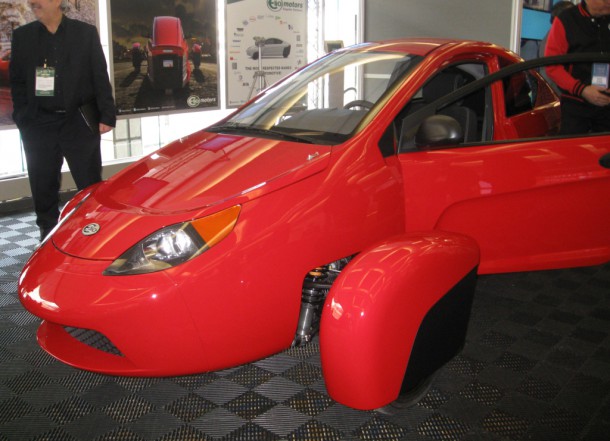
Elio Motors has also arranged for the stock to soon be listed on the OTCQX over-the-counter exchange so investors in the company have liquidity if they want to divest. In order to list the stock on an exchange, securities laws require closing out the Reg A+ offering. If you want to take up that particular offer, you have only until February 1, 2016 to do do.
Selling stock puts the company in an interesting position. On one hand, that’s exactly the kind of thing that got Preston Tucker in trouble. Selling stock to the general public before production begins opens up Elio to charges that it’s an investment scam, not a serious effort to go to production. The fact is, however, that the company comes under greater scrutiny by selling stock because it now has outside shareholders and the Securities and Exchange Commission to protect those shareholders’ interests.
So far, Elio claims to have over 48,000 reservations, the majority of them being non-refundable. Paul Elio describes some Elio enthusiasts as “all in, all in,” meaning that they’ve made non-refundable reservations and also invested money in the company.

Should they reach production, plans are to start with a single shift at the former GM assembly plant in Shreveport, LA, building 500 cars a day, eventually going to two shifts and a goal of selling a quarter million trikes a year.
There was some recent news about proposed rule changes at the National Highway Traffic Safety Administration that would regulate “car-like” three-wheelers as cars, not as motorcycles as they are federally regulated now. Elio Motors believes that the fact that they are making a tandem vehicle, not one with side-by-side seating, will exempt them if the rule comes into force.
In any case, the company is lobbying NHTSA to create a third class of motor vehicles: autocycles. Previous lobbying efforts at the state level have been very successful, so in just about every state Elio trike drivers will not have to wear helmets.
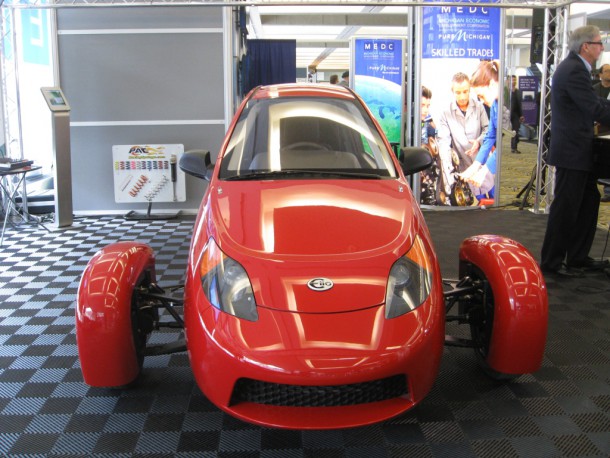
At the Detroit show, I was talking to Jalopnik’s Michael Ballaban about Elio as we walked to their press conference and he said that he didn’t think Elio was a scam, but he was turned off by the hype with which they were promoting both the car and their stock offers. In a related vein, Ballaban’s colleague at Jalopnik, Jason Torchinsky, wrote about a change in Elio’s advertising. They’re now saying that $6,800 is a “targeted” base price and that the trike will get “up to” 84 mpg. Torch finds the “up to” wiggle words troubling. So do I, but I think I know why Elio is now using them.

All along, Paul Elio has been pretty straightforward that they were still working at getting the cost down to where they can have a MSRP of $6,800. Last year, he told me they were within a few hundred dollars. You’d be surprised where you can save money on an inexpensive car, though Elio will be using four lug nuts per wheel instead of the three that the Tata Nano had at launch. For example, using hood pins instead of a cable operated latch saves Elio about $40 per vehicle and reduces weight.
Regarding the 84 mpg figure, that was baked into Elio’s design brief cake by an American fleet highway mpg average of about 28 mpg and Elio’s novel financing scheme. The idea is that the price of the car is put on an Elio issued credit card that bills gasoline purchases at triple the pump price, with the overage going to pay off the car. The idea was that if the Elio trike can get three times the gas mileage versus the 20-year-old commuter beater their target customer is now driving, that customer can have a new commuter vehicle with a warranty and the gasoline to run it for the same amount of money they are currently spending on gasoline alone. For what it’s worth, that’s exactly the kind of promotional gimmick that makes folks like me and Torchinsky roll our eyes.
With less than two dozen people on their payroll, I doubt that Elio has the engineering or computer resources to accurately model what kind of fuel economy they can expect from the production trike. I suspect the only way they’ll know what kind of fuel consumption it will achieve is by wind tunnel and real world testing of a production-ready prototype. Considering the number of big car companies that have had to admit that some of their production cars don’t quite meet their projected fuel economies, the fact that the folks at Elio are giving themselves some wiggle room is no big deal in my eyes. Besides, I’m pretty sure when fuel economy started becoming a big thing in the wake of the 1973 oil embargo by OPEC, plenty of established automakers used the words “up to” when advertising highway mileage.
As they get closer to production, Elio is hedging their bets on price and fuel economy. To be honest, I don’t think it will be a problem for the general public. Most folks have never heard of Elio nor their price and mpg targets, so if Elio Motors does bring a $7,500 trike that gets 80 mpg on the highway, that’s probably just as viable in the market as their targeted figures. Today, Elio’s biggest critics are people who put down deposits only to become disillusioned as production has been pushed back more than once. If Elio comes to production but misses its targets, I suspect that a measurable number of those 48,000 reservation holders will join the critics.
The bottom line, though, is that Elio Motors appears to be making progress. The enterprise is still a longshot. While projected target dates have been missed, every benchmark that they positively had to reach have been met so far.
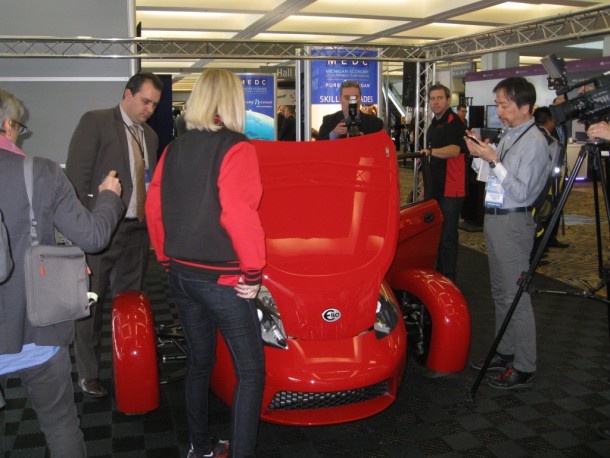
Sometime this summer I should be able to drive the P5 prototype. Around the same time, we should start seeing news on some of those E series trikes. Elio Motors is almost literally banking on the hope that the close-to-production E series prototypes will convince the Department of Energy that they’re worth the ATVM loan. Otherwise, I don’t see any way that they can start production by the end of this year, as they’ve projected.
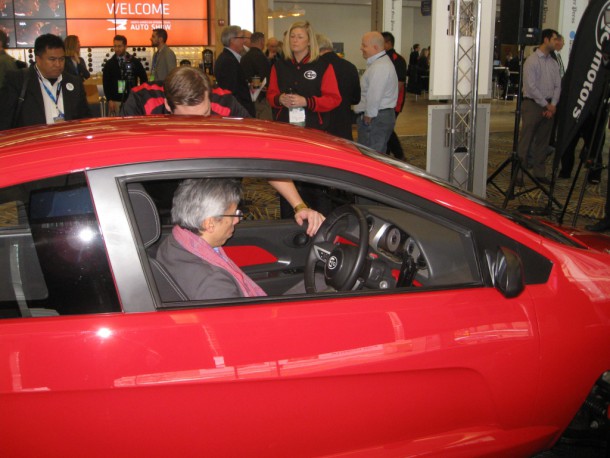
After the NAIAS media preview was over, I went back to Cobo Hall during the industry preview, when people who work for car companies and their suppliers come to fly their flag and check out the competition. There was a steady stream of visitors to the Elio booth in the concourse. Some were from Elio vendors, and they all looked uniformly happy. Everyone else checking out the trike looked genuinely interested, not skeptical.





One of my neighbors has a 1985 Pulse Autocycle Motorcycle.
I can see the market for these in China. When I lived there, I saw Mothers taking their children to school – on the back of bicycles – in freezing rains.
A Plug-in version of this should sell like hotcakes in the poorest countries. Naturally an I.C.E or PHEV would be better.
IT’S A SHAME THAT THIS IS SO UGLY.
Why not have the same “Jet fighter styling”? Hell, even the T-Rex looks better. My guess is the stupid pedestrian protection regulations.
Should just put a spear at the end of it and make pedestrian shish-ka-bobs.
Should have paid attention instead of being in the crosswalk staring down at your ipod.
Such a car would not work in the 3rd world either.
Firstly they have a need for more than 1 normal seat and 1 midget seat. Hell I have a need for more than that which is why I dont have a 370z.
Secondly, usd$7,000 would be more than many of them see in a lifetime.
Thirdly, there are lots of ‘cars’ in the 3rd world that are cheaper than this with 4 normal seats. Granted the safety isnt there but the 3rd world isnt a safe place.